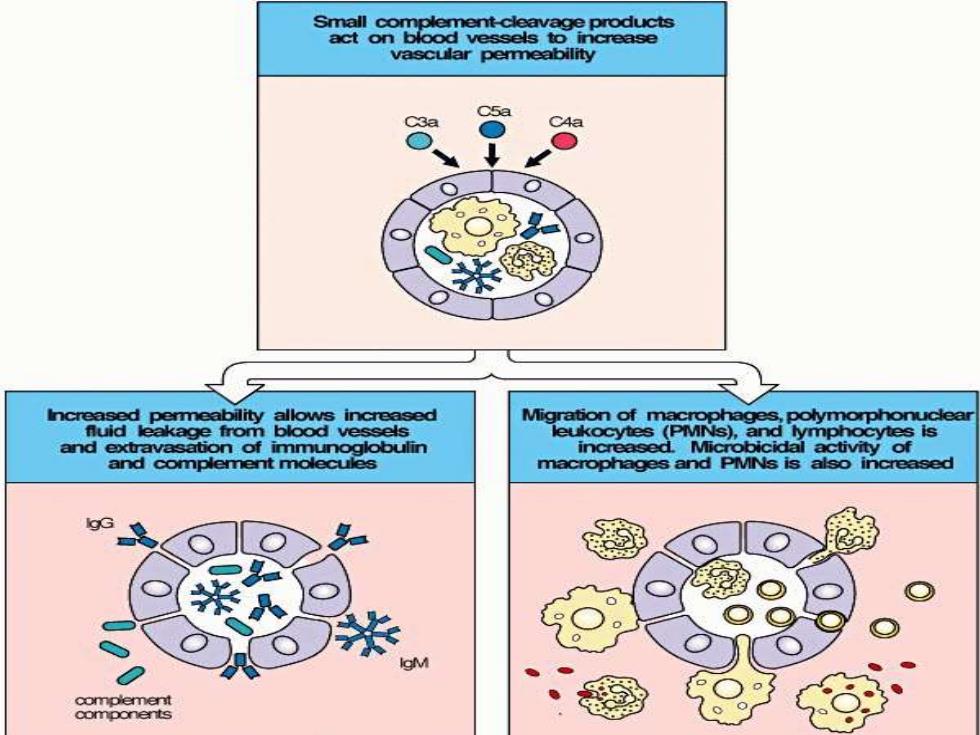
The Complement System A group of 30 plasma proteins which comprise the primary soluble component of innate immunity. Rapidly activated in response to infection, without induction or recall of adaptive immunity
The Complement System A group of > 30 plasma proteins which comprise the primary soluble component of innate immunity. Rapidly activated in response to infection, without induction or recall of adaptive immunity

The Complement System However,in the presence of an adaptive immune response,complement proteins interact with both its soluble and cellular components (antibodies,lymphocytes, activated macrophages,dendritic cells). Complement proteins circulate in plasma as inactive precursors
The Complement System However, in the presence of an adaptive immune response, complement proteins interact with both its soluble and cellular components (antibodies, lymphocytes, activated macrophages, dendritic cells). Complement proteins circulate in plasma as inactive precursors

The Complement System Infection results in activation of complement proteins via a series of proteolytic reactions that yield biologically active fragments. These coupled proteolytic reactions result in an amplification cascade,in which limited stimulation of proximal complement components results in massive activation of distal complement proteins
The Complement System Infection results in activation of complement proteins via a series of proteolytic reactions that yield biologically active fragments. These coupled proteolytic reactions result in an amplification cascade, in which limited stimulation of proximal complement components results in massive activation of distal complement proteins

Complement System:Overview CLASSICAL PATHWAY LECTIN PATHWAY ALTERNATIVE PATHWAY Antigen:antibody complex Lectin binding to pathogen Pathogen surfaces surfaces Complement activation Recruitment of Opsonization Kiling inflammatory cells of pathogens of pathogens Rin
Complement System: Overview

Small complement-cleavage products act on blood vessels to increase vascular permeability 3a Increased permeability allows increased Migration of macrophages,polymorphonuclear fluid leakage from blood vessels leukocytes(PMNs),and lymphocytes is and extravasation of immunoglobulin increased.Microbicidal activity of and complement molecules macrophages and PMNs is also increased gG complement components

CLASSICAL PATHWAY LECTIN PATHWAY ALTERNATIVE PATHWAY Antigen:antbody complex Lectin binding to pathogen Pathogen surfaces surfaces Complement activation Recruitment of Opsonization Kiling inflammatory cells of pathogens of pahogens 1997 Current Bioloay Ltd.Garland Publishing.Inc

Complement proteins opsonize microbes and promote their phagocytosis. Encapsulated bacteria resist Binding of antibody to becterial Uptake of bacteria into Granules fuse with phagosomes uptake by neutrophils and surface also leads to the binding neutrophil phagosomes mediated producing toxic oxygen avoid engulfment of the complement protein,C3b by Fc and C3b receptors metaboltes that kill bactera 1997 Current Biology Ltd./Garland Publishing.Inc
Complement proteins opsonize microbes and promote their phagocytosis

Complement receptors on the surface of leukocytes bind complement proteins Phagocytic receptors:CR1,CR3,CR4 present on neutrophils,monocytes, macrophages,dendritic cells. Bind C3b C3bi that are attached to microbial surfaces (as opsonins)-> phagocytosis
Complement receptors on the surface of leukocytes bind complement proteins Phagocytic receptors: CR1, CR3, CR4 - present on neutrophils, monocytes, macrophages, dendritic cells. - Bind C3b / C3bi that are attached to microbial surfaces (as opsonins) → phagocytosis

Complement receptors on the surface of leukocytes bind complement proteins CR2:surface of B cells and dendritic cells. Binding of activated complement fragments to CR2 amplifies antigen-induced cellular activation provides a link between the innate and acquired immune systems
Complement receptors on the surface of leukocytes bind complement proteins CR2: surface of B cells and dendritic cells. Binding of activated complement fragments to CR2 amplifies antigen-induced cellular activation - provides a link between the innate and acquired immune systems

CLASSICAL PATHWAY LECTIN PATHWAY ALTERNATIVE PATHWAY Antigen:antbody complex Lectin binding to pathogen surfaces Pathogen surfaces Complement acivation Recruitment of Opsonization Kiling inflammatory cells of pathogens of pathogens 1997 Current Bioloay Ltd./Garland Publishing.Inc